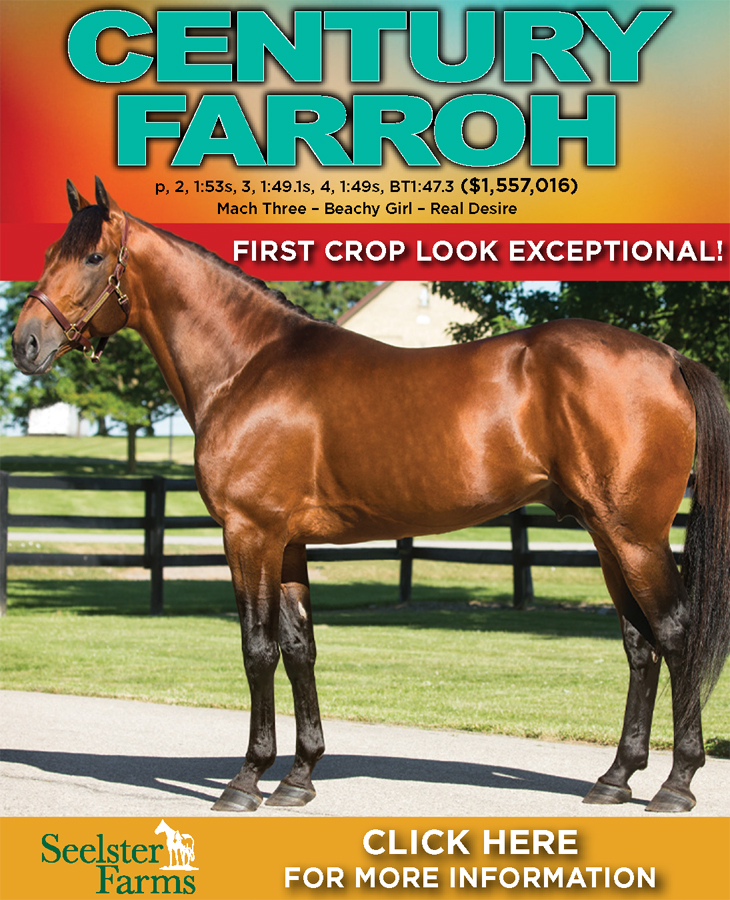

The road less traveled
Adventures in the yearling marketplace.
by Trey Nosrac
Yearlings are consigned in the spring, prepped and cataloged in the summer, and sold at a public auction during the fall months. After the sales, buyers send yearlings to professional trainers and, about seven months after the auctions, hope they “got a good one.” This cycle is the standard(bred) operating procedure.
The beaten track is the safest and smoothest route. Nothing wrong with this road. We have followed it in the past. During the week of a sale, I add a few personal touches such as chewing on Valium and, during the live bidding, locking myself in my car to chant mystic mantras until my partner knocks on the window and gives me a thumbs up or down.
Beaten paths with fixed timetables can be boring and have a lot of traffic. A flexible schedule and a trip down the road less traveled are possible, of course, but roads less traveled can lead to dead ends and trouble. Fortunately, our sport has a place for people who want to go rogue and march to a different drum. Participants in the various sections of our sport can wing it. **
This year, we are improvising with a yearling named Miss Unorthodox. The name of the yearling is fictitious. The lunacy is non-fiction.
The lusty month of May was the springboard for this off-road adventure when we wrestled with our annual Hamlet-like choice of “To sell or not to sell” our yearling. Economics and forecasting future market trends always come into play during this choice. Depending on the stud fee, we calculate that the gavel needs to fall between $18,000 and $25,000 to break even on our equine investment. Happily, the first foal from this mare accomplished this goal at a yearling sale last year.
Not so happily, we do not forecast this season’s yearling selling for a profit; although one never knows in the chancy game of yearling auctions. Our current yearling has a few marketplace dings. Miss Unorthodox is a red filly. For some reason, there seems to be a bias against red racehorses. Also, the stallion we choose for this yearling has yet to soar; although the third crop may catch a second wind.
As very small-timers in the harness racehorse breeding business, we have options that large farms do not. We can skip the sales and keep this filly for racing. Or, and this is the thrust of this little off-road adventure, with the Internet, we can market her privately, whenever and however we wish.
In 2023, email, Facebook, online marketing, online auctions, video clips, and a hundred new inventions are at our fingertips. Why can’t Miss Unorthodox’s schedule be flexible for marketing? Why do we need to watch the calendar? Why can’t we delay our decision to sell or not to sell? We may decide to market her before the sales, after the sales, after qualifying, or not at all.
My mantra is that each baby horse is a story. I enjoy hearing them and telling them. For the beginning of this story, we opted to skip sales and keep her. A couple of factors pushed us in this direction. Her color does not matter to us. As a youngster, she trotted up a storm in the field and seemed confident in her herd of 26 fillies. And while the ability of the first foal in her racing career as a 2-year-old is an unknown, we have good vibes and promising reports.
Our rough plan is unorthodox and risky because many customers may be uncomfortable outside traditional time sequences. But I once bought a 2-year-old deep into training, sold a weaning in February, and bought into a horse during Christmas without incident.
Some wheels for Miss Unorthodox are already in motion. Several ideas are percolating. We are already out of step from our regular yearling sale routine. Instead of having our yearling spruced up for her sales video, we sent Miss Unorthodox to a friendly young fellow down the lane with a nice little farm track for breaking and easy foundation miles under her hooves. We visited her in action much sooner than any horse we have owned.
Then, while most yearlings are loaded onto trailers and heading for the auction ring, Miss Unorthodox will return to the breeding farm for a very long turnout over the winter. She will return to another track for more foundation miles depending on the weather. We are winging it. As always in the yearling game, our hopes are unreasonably high.
Miss Unorthodox will help set her own trotting pace.
We are not obsessed with racing at age 2. Miss Unorthodox is not a late foal or immature, but 2-year-old racing is stressful for owners, trainers, and horses. Of course, money is on the table during the 2-year-old racing season. Perhaps we
will send her to an established trainer at some point,
but hiring a novice is undoubtedly on the table. We may sell her when the potential buyer can examine or take her for a spin. We may purchase a thousand-dollar advertisement in HRU for a private sale. Maybe we will decide to list the horse on Preferred Equine online or onGait at some point. Perhaps we are insane.
Whatever. We turned off the clock. We are having fun,
waiting, discussing different scenarios, and watching the story unfold.
** The expression “wing it” did not evolve from flying birds or throwing baseballs. The term is theatrical. First recorded in 1885, “winging it” refers to an actor studying a role in the wings — the areas to either side of the stage — suddenly called to replace another actor. The term has expanded to other kinds of improvisation based on unpreparedness.














